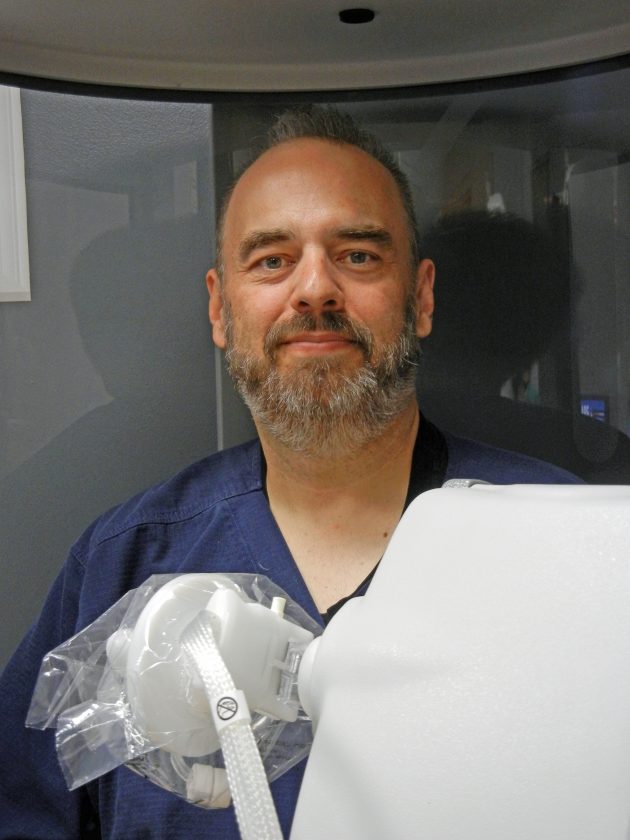Doctors at WVU Medicine Black Lung Clinic Say Disease Often Goes Undiagnosed

May 16, 2022 - Nearly two years after a COVID-softened opening, a local clinic dedicated to diagnosing and managing black lung – an occupational disease caused by inhaling coal dust — has amassed more than 200 patients, according to its management team.
“It’s waxed and waned a little bit,” said Dr. Neal Aulick, one of two physicians who treat black lung patients at the WVU Medicine Reynolds Memorial Hospital site in Glen Dale. “Patients were afraid to come into the hospital because that’s where COVID was. That makes sense.”
Now, clinic administrator Kathleen Richmond said the opportunity to be treated locally rather than at a handful of dedicated, federally-funded clinics scattered elsewhere around the state is catching on, seeming to spread by word of mouth more than through formal advertising.
“They’re saying they heard about it from a buddy,” Richmond explained, noting she’s hoping that network or some other form of encouragement will kick into a higher gear.
Richmond and Aulick said there are enough living coal miners in Marshall, Ohio, Wetzel, Brooke and Hancock counties – the region the clinic serves – that there should be a notably higher patient load.

Photo by Nora Edinger
(The state Office of Miners’ Health, Safety and Training records about 58,000 West Virginians working in and around coal mines as of April, the vast majority of them being independent contractors. More than 8,200 miners work underground, 1,734 in surface mining, 402 in quarries and 1,349 in prep plants. And, while southern West Virginia is often perceived as the state’s “coal country,” Statista.com records show that, as of 2020, Marshall County was the state’s largest producer. Ohio County (third largest) nearly tied for second with Logan County.)
An analysis released in 2020 by the University of New Hampshire’s Carsey School of Public Policy would agree with the local black lung experts’ suspicion that disease is likely being missed. Among analysis findings was an unprecedented resurgence of the disease that began in the early 2000s, about the same time coal production began to decline nationally.
More specifically, the Carsey analysis reported that recent testing among coal workers in West Virginia, Virginia and Kentucky showed more than one in five long-term miners (at least 25 years of employment) were positive for black lung, more formally called coal workers’ pneumoconiosis.
On the ground in the Northern Panhandle, Aulick said he is seeing a range of debilitation among current patients and suspects a mix of stoicism and wishful thinking is in play among those who are reluctant to be tested.
“They don’t want to know they have a problem,” Aulick said of the latter. “They have a very well-paying job and they don’t want to have to leave it.”
Long Haul
The conflict between money and health has been a long-standing one in the coal industry, he noted. Miners need income and the progressively debilitating nature of black lung threatens that.
“There really is no treatment. It’s oxygen,” Aulick said of what is functionally a structural disorder of the lungs. He added that smoking cessation, good nutrition and exercise can play a part in managing the disease, but there is generally a downward trend.
“If you’re bad enough you’re on oxygen, you could not work in the mines,” he specified of the income conundrum.
That said, Aulick added that he is confident there are miners who are still working who are already rather disabled by the disease, which traps coal dust in the lungs and progressively makes respiration more difficult. “They’re just pushing through it.”
Cost is also a factor for coal companies, he said, noting such have historically been reluctant to pay benefits — whether that’s directly to current mine employees or into a government-managed fund that covers healthcare and compensation for those workers (past or present) who are diagnosed with the disease.
“In the bad, old days, if a person had any component of COPD, they were blaming it on smoking and denying the claim,” Aulick said, acknowledging about half the clinic’s patient load has a history of smoking.
He added that existing companies still often fight direct payment of benefits – something he said he knows firsthand, as the clinic’s duties include assisting with the state and federal paperwork associated with black lung claims. Richmond noted that some patients are applying for benefits – a lengthy process — knowing whatever they get will likely go only to their survivors given the advanced nature of their disease.
Ironically, Aulick noted, his current caseload is revealing a disturbing trend given those circumstances.
Workers as young as their 30s — particularly those engaged in strip mining or who work in prep plants where he suspects there are fewer protections in place because of the perceived safety of an outdoor environment — are coming in with a level of disease progression that would historically have been more likely in a retirement-aged miner.
These younger, rapidly sickened miners would be among the few who would be considered for a lung transplant, Richmond noted. Their otherwise-better health would be more likely than that of older miners to see them through such a major surgery.
“It’s highly variable,” Aulick said of which miners fall ill and how badly and quickly they progress. “There might be a miner who’s been working since 50 years ago with no problems and another with only 10 years of work who’s completely debilitated.”
Aulick acknowledged that many younger workers won’t come in to be checked unless they hit that debilitation zone. But, given that black lung can worsen even after exposure to coal dust stops, he’s hoping a high percentage of older miners will take advantage of the clinic’s proximity.
“It’s very important as soon as you retire from the mines to be checked, just to have that baseline,” Aulick said, noting the clinic also serves a small number of patients who have been occupationally exposed to silica and have developed silicosis.

